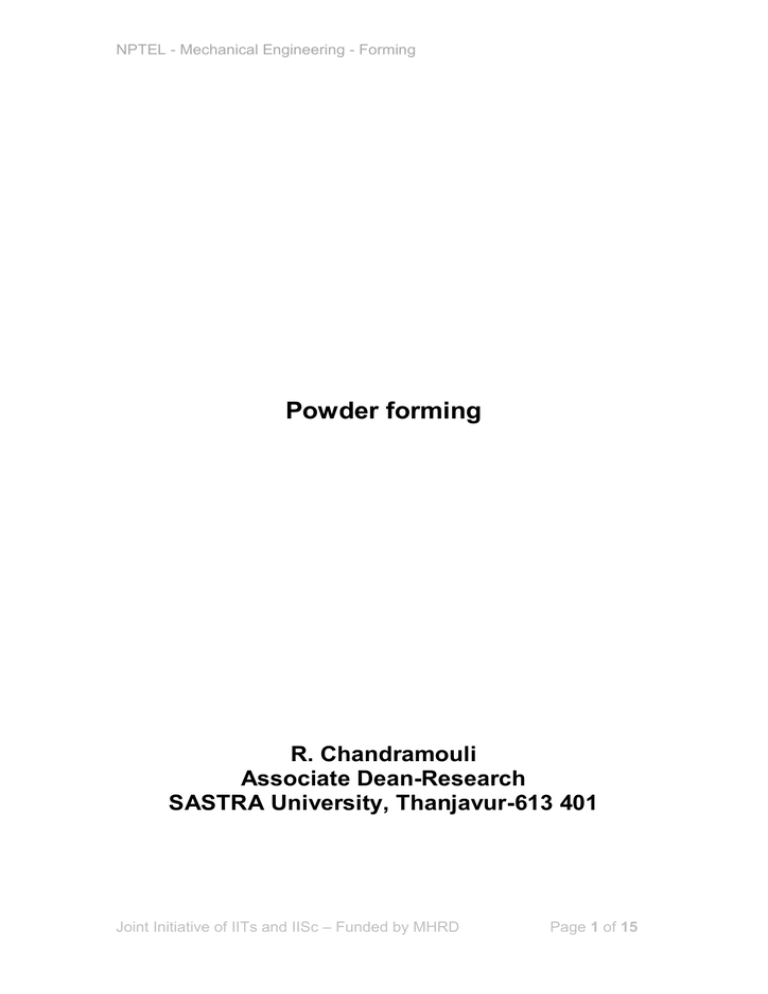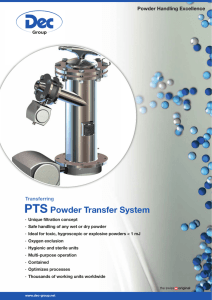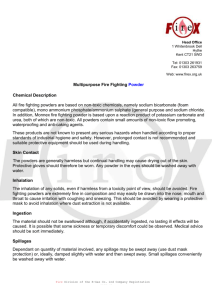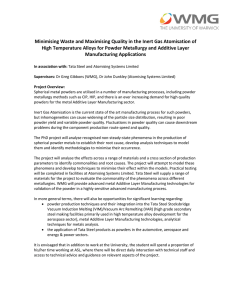Powder forming
advertisement

NPTEL - Mechanical Engineering - Forming Powder forming R. Chandramouli Associate Dean-Research SASTRA University, Thanjavur-613 401 Joint Initiative of IITs and IISc – Funded by MHRD Page 1 of 15 NPTEL - Mechanical Engineering - Forming Table of Contents 1. Powder forming: ...................................................................... 3 1.1 Introduction...................................................................................................................... 3 1.2 Powder metal processing: ................................................................................................ 4 1.2.1 Production of metal powders: ................................................................................ 4 1.2.2 Powder metal particle characteristics: ............................................................... 5 1.2.3 Powder mixing and compaction: ........................................................................... 6 1.3 Sintering: ................................................................................................................................. 8 1.4 Post sintering processing: ............................................................................................. 11 1.5 Powder forging: ................................................................................................................. 11 1.6 Deformation of porous preforms: .............................................................................. 13 Joint Initiative of IITs and IISc – Funded by MHRD Page 2 of 15 NPTEL - Mechanical Engineering - Forming 1. Powder forming: 1.1 Introduction In conventional manufacturing processes such as forming, casting, machining etc, the raw materials used are often in the form of solid materials or solids melted to liquid state. A new class of manufacturing process, called powder metal forming has emerged in recent times. Powder forming utilizes metal or alloy powders as raw materials in order to obtain finished parts of high precision and accuracy, at competitive costs. Considerable saving in raw material could be achieved in powder forming, as very little after-machining is required for the formed powder metal components. Powder forming is a net-shape forming operation which is capable of producing complex shapes with wide range of properties, in high volumes. Flexibility of material composition, coupled with tailor-made properties imparted to the powder metal components due to wide range of microstructures are added advantages of the process. Materials, such as ceramics, which are difficult to process through casting because of their high melting point temperatures, could be processed through the powder metallurgy (P/M) route without difficulty. One of the inherent disadvantages of powder forming is porosity in the finished part, which significantly reduces the mechanical strength, hardness, wear resistance and fatigue strength of the formed parts. Large size components are difficult to produce through powder metal processing. However, P/M processing is competing with casting, forging, machining and extrusion of conventional wrought materials, due to the enhanced formability of powder metal preforms. Examples of parts made by P/M process include gears, connecting rods, pistons, hydraulic valves, valves, etc. Nearly 65% of the components used in modern automobile are manufactured through P/M. Aerospace and defence sectors are increasingly utilizing P/M parts for high precision applications. Joint Initiative of IITs and IISc – Funded by MHRD Page 3 of 15 NPTEL - Mechanical Engineering - Forming 1.2 Powder metal processing: Powders are very small size particles having diameters from 0.1 to 200 micrometers. Powders of nano size (less than 200 nano meters) are possible. Human hair typically has a diameter of 100 micrometers. (1 micrometer = 10-6 m). Powder metallurgy involves production of metal or alloy powders and compacting them to required shape in green condition, followed by sintering at high temperature to achieve the required strength. The general steps involved in powder metallurgy processing are: a. Production of metal powders, b. Powder mixing or blending, c. Powder compaction, d. Sintering and e. Post-sintering operations. The following section briefly discusses the above-mentioned steps. 1.2.1 Production of metal powders: The raw material for the production of metal powders may be the bulk metal, compounds of the metal, salts and oxides of the metal. The nature of the powder produced and its characteristics such as particle shape, size, composition etc depend on the method of production of the powders. The commonly employed methods of producing metal powders are: atomization, reduction, mechanical alloying, electrolytic deposition etc. Atomisation: In this process, the molten metal or alloy is injected through a small orifice and the emerging liquid stream is broken into fine droplets by a jet of air, steam or inert gas. The fine droplets, when cooled form fine particles of varied shapes. The particle size formed depends on the size of the orifice, temperature of the metal, pressure or velocity of the atomizing gas stream etc. Atomisation produces finer powders with spherical shape and smooth surface. In rotating electrode method of atomization process, the molten metal from the tundish is made to fall on a rotating disk, which breaks the molten liquid into small droplets. Centrifugal atomization involves a spinning disk with a consumable electrode inside a helium filled chamber. Centrifugal force breaks up the molten electrode into small droplets, which cool down to fine particles. ---figure of atomisation Joint Initiative of IITs and IISc – Funded by MHRD Page 4 of 15 NPTEL - Mechanical Engineering - Forming Electrolytic deposition: Metal powders of high purity and finer size could be produced by this process. In this process, metal powders are produced by electrochemical reaction involving aqueous solution or fused salt. Reduction of oxides: Metal oxides of fine size are reduced with reducing gases such as carbon monoxide, hydrogen to pure metal. Spherical, porous powders of uniform size could be produced by this process. Ball milling: Two or more metal powders are ball-milled in a high speed chamber using tungsten or carbide balls. This process results in production of mechanically alloyed intermetallics. Powder particles of nano size could be produced by ball-milling process. Ball milling is also used for producing fine particles from brittle metals. Elementary metal powders or alloy powders with various alloying elements can be produced by the above processes. Alloy powders ensure physical and structural homogeneity of the finished part, but requires higher compaction pressures to achieve a given density. 1.2.2 Powder metal particle characteristics: Particle characteristics such as shape, size and size distribution are important for processing metal powders successfully into finished parts. Particle shape is expressed by shape factor. Shape factor is ratio of surface area to volume of particles multiplied by equivalent diameter of a sphere of same volume. Higher shape factor indicates long, flaky particles. Surface area of particles is measured by BET method. The adsorption of some species in solution as a monolayer on the powder surface and subsequent calculation of area of a single molecule gives the estimation of surface area. Particle size is measured by sieve analysis. In this process, a known mass of the metal powder is passed through a series of sieves of different mesh size. A mesh Joint Initiative of IITs and IISc – Funded by MHRD Page 5 of 15 NPTEL - Mechanical Engineering - Forming size of 100 has openings with diameter of 150 microns. Higher mesh size indicates smaller particle size. Particle size can also be studied using optical or electron microscopes. Particle size distribution is important from the point of powder processing such as compaction. Size distribution is usually expressed as percentage mass of the powders which pass through a sieve of particular size. Compressibility of powders gives an indication of the extent to which the metal powder can be compacted and densified by the application of a certain force. It is expressed by a curve between density of compact and applied stress. Larger compressibility means larger forces are required for compacting a given powder. 1.2.3 Powder mixing and compaction: Blending refers to mixing of same kind of metal powders whereas, mixing refers to the uniform mixing of powders of different kind. Mixing or blending of elementary powders is carried out in mixers or ball mills or attritor mills under inert or controlled atmospheres. Oxidation and explosion of powders should be prevented during mixing by ensuring inert atmosphere in the mixer. Powder size could be controlled using high speed ball milling of the powders. Compaction of metal powders is the process of pressing green powders inside closed die-punch assembly. Powders are compacted by applying suitable pressure through punches. Lubrication is necessary to reduce inter-particle friction and particle-die wall friction. Lubricants such as graphite powder, zinc stearate powders are usually blended with metal powders before compaction. Density of compacts is important from the point of view of handling the green compacts. In compaction the particles come closer and establish contact. A heterogeneous mix of particle shape and size will promote uniform density of compacts. Softer powders promote higher green density. Similarly, higher compaction pressure leads to higher density of the compact. Admixed lubricant also promotes higher green density. The density of the compact is not uniform along the compact height due to non-uniform transfer of compact pressure from the punch to the compact. The distribution of compaction pressure along the height of a powder compact is given by the exponential expression: Joint Initiative of IITs and IISc – Funded by MHRD Page 6 of 15 NPTEL - Mechanical Engineering - Forming px = poexp- , where po is pressure on the contact surface between punch and powder compact. k accounts for inter particle friction, along die wall. is friction coefficient Fig. 1.2.3.1: Powder compaction process sequence Compaction die and punch are often manufactured from die steel, though Compacting pressure varies for different metal powders. Alloy powders require higher compaction pressures. Normally the pressure varies from 300 to 800 MPa for iron and from 50 to 300 MPa for aluminium powders. Hydraulic presses of capacity upto 300 tons is commonly used for compaction. Usually the maximum density achieved in uniaxial compaction is limited to 95%. In order to achieve near full density in compaction cold or hot isostatic pressing could be employed. Cold isostatic pressing involves the application of hydrostatic pressure using a hydraulic medium on the powder contained inside a flexible container such as rubber or leather bag. Pressures upto 1000 MPA are applied. Hot isostatic pressing is carriedout in a container made of sheet. The metallic container with the powder is heated to high temperature – upto 1300 K, uniform pressure of Joint Initiative of IITs and IISc – Funded by MHRD Page 7 of 15 NPTEL - Mechanical Engineering - Forming 100-200 MPa is applied, in order to obtain 100% density. Uniform densification is achieved in isostatic pressing. Powder rolling in another compaction process, in which the powder is fed into the roll gap of a pair of rolls. The compacted strips are passed onto a sintering furnace. Thin sheets long and continuous can be produced by powder rolling. Powder extrusion – both hot and cold extrusion can be done at room temperature or at elevated temperature. Higher extrusion pressures are normally required for powder extrusion. In powder injection molding, the metal powder is mixed with 30 – 40% polymer binder, squeezed inside a molding die, at 400 to 500 K, similar to plastic injection molding, debinding is done at 400 K and sintered. PIM process is commonly used for making intricate parts out of metals such as steels, titanium, copper, tool steel etc. It has high productivity, suitable for mass production and is a competitive process as against forging or casting. Warm compaction is carried out at slightly higher temperatures but below temperatures on-half the melting temperatures. Warm compaction is often used for hard, abrasive powders, as the higher temperature of compaction softens the powders. ---- Powder rolling diagram 1.3 Sintering: Green compacts do not have sufficient strength and they may collapse even under small loads, because the particles are loosely bonded with each other. They also contain porosity between the particles. In order to eliminate porosity and to establish metallurgical bond between powder particles, sintering is carried out after compaction. Sintering is the process in which the compact is heated to a temperature below melting point in order to achieve chemical bonding of particles by the process of interparticle diffusion, plastic deformation, grain formation and grain growth. If the sintering temperature is higher than the melting temperature of one of the metallic components of the compact, then Joint Initiative of IITs and IISc – Funded by MHRD Page 8 of 15 NPTEL - Mechanical Engineering - Forming liquid phase sintering occurs. Liquid phase sintering enhances the density of the compact. Sintering is to be performed in controlled atmosphere in order to prevent oxidation of the surface of the compacts. For ferrous materials, nitrogen- hydrogen gas mixture is used as sintering atmosphere. Cracked ammonia is often used as source of nitrogen and hydrogen. Other gases such as argon, helium, nitrogen are also used as sintering atmosphere. During sintering, the following stages are known to occur: Particle bonding by necking Neck growth Pore channel closure Pore shrinkage Various factors influence the sintering process. Some of the factors are: sintering temperature, sintering time, sintering atmosphere. Sintering temperature is often within 90% of the melting temperature of the metal. Higher sintering temperatures promote higher densification. Larger sintering time often leads to higher sintered density. Similarly, higher initial compact density results in higher sintered density. Vacuum sintering of stainless steels leads to better densification. Sintering temperature Ten sile str eng th Joint Initiative of IITs and Sintering IISc – Funded time by MHRD Page 9 of 15 NPTEL - Mechanical Engineering - Forming Fig. 1.3.1: Effect of sintering temperature and time on tensile strength Hard metal powders or ceramic powders are often sintered by a process known as spark plasma sintering. In this process, the metal powders, contained in a graphite mold are subjected to high current discharge while getting compacted. This ensures near-full densification. During sintering, the compact undergoes shrinkage upto 5%. Volumetric shrinkage during sintering can be estimated using the expression: Vsinter = Vgreen (1- )3 Where Lo is initial length. Typical sintering temperature and time for some of the common metals are given below: Material Sintering temperature, K Time, minutes Iron 1275 – 1425 10 – 45 Stainless steel 1375 – 1575 30 - 60 Copper, brass Tungsten Aluminium 1035 – 1175 2626 873 10 – 45 480 20 Sintered density greatly influences the mechanical properties of the components. Higher density enhances the tensile and fatigue strengths. Ductility is also improved by reduction in porosity. Joint Initiative of IITs and IISc – Funded by MHRD Page 10 of 15 NPTEL - Mechanical Engineering - Forming Tensile strength Fatigue strength % elongation Sintered density, % Fig. 1.3.2: Effect of sintered density on mechanical properties 1.4 Post sintering processing: Tensile strength, ductility and fatigue strength of powder metal parts are considerably degraded by the presence of porosity in sintered material. Porosity may be present in the form of interconnected pores or individual voids. Porosity is helpful for some applications such as bearings and filters. Pores retain the lubricating oil in sintered bearings. High strength applications require pore-free p/m parts. Additional operations may be necessary after sintering in order to eliminate porosity in sintered parts. Some of the important post-sintering operations which help improve the density of the sintered material are: Forging, extrusion, repressing, infiltration. We discuss these operations in the following section: 1.5 Powder forging: The sintered metal/alloy preform is subjected to upsetting , repressing or forging inside closed dies, so that the desired final shape of the part is achieved in a single step. Forging can be done at room temperature or at elevated temperature – commonly at 0.5 to 0.7 times the melting temperature of the alloy. Cold forging is common for non-ferrous alloys such as alloys of aluminium. Joint Initiative of IITs and IISc – Funded by MHRD Page 11 of 15 NPTEL - Mechanical Engineering - Forming Ferrous alloys demand forging at high temperature due to their reduced formability and high melting temperatures. Forging often results in density upto 99% or 99.5% of theoretical density of the alloy. Often it is economical to combine sintering and hot forging in a single step. First the green compact is heated in a furnace up to sintering temperature for the required duration. It is immediately followed by hot forging of the sintered preform by transferring it from the furnace to the forging die. This way considerable saving in energy could be achieved. Cold forged parts have good surface finish and dimensional tolerances. However, hot forging requires lower loads and easy flow of material occurs. In upset forging, there is always the chance of occurrence of surface cracks due to excess tensile stress. In closed die forging such surface cracks generally avoided. Further, closed die forging of sintered material does not require flash. ---------- Diagram of forging Fig. 1.5.1: Powder extrusion process Repressing: The sintered preform is subjected to flow constraint in the lateral direction in repressing operation. This prevention of lateral flow is achieved by pressing the sintered preform inside close die. Repressing, otherwise known as Joint Initiative of IITs and IISc – Funded by MHRD Page 12 of 15 NPTEL - Mechanical Engineering - Forming coining often results in lower densities compared to closed die forging. This may be due to the incomplete closure of pores, especially those smaller pores which got rounded during the pressing process. Uniform and finer grain size is an added advantage of powder forging. Numerous applications involving high stress or wear, such as connecting rods, gears, cams, main bearing caps etc used in automobiles are often powder forged products. 1.6 Deformation of porous preforms: Plastic deformation behavior of porous preforms differs significantly from conventional wrought materials. Poisson’s ratio of porous preforms is a function of density. There is volume change of the sintered preform during plastic deformation, unlike conventional materials. Similarly, the yield criterion for porous materials is also a function of density. A simple yield criterion for porous materials has been proposed by Khun. It is given by: [ 1/2 Plastic Poisson’s ratio for sintered porous preforms in terms of preform density and theoretical density is given by the expression: During axial deformation of a sintered porous cylinder, the axial strain varies with density of the deforming preform. The axial strain as a function of the instantaneous and initial densities of the sintered preforms is given by: 1/2 Joint Initiative of IITs and IISc – Funded by MHRD Page 13 of 15 NPTEL - Mechanical Engineering - Forming Note: The derivation of the above equation can be done starting from first principle, namely, equating the volume change (or density change) of the preform to the total strain of the preform: We know that Substituting for and into the equation for density change, above, and also applying the plastic Poisson ratio expression given above, we get the required equation. Infiltration: In this process, a molten low melting metal is made to flow into the pores of a porous metal by capillary action, so that the pores get filled. Copper is often used for infiltrating iron based porous alloys. Some of the bearings are formed by infiltration process. Similar process is oil impregnation of porous alloys for bearing applications. The evacuated porous alloy is immersed in oil so that the pores get impregnated with oil. Universal joints used in machines and automobiles are often made by this process in order to avoid application of grease lubricant. Surface treatment can be done on powder metal parts in order to improve their surface wear resistance and hardness. One common process is steam treatment of the surface of sintered ferrous alloys. Exposure of the surface to steam results in formation of thin oxide layer on the surface, which imparts high surface hardness and wear resistance. Example -1: Iron powders have particle density of 1.4 g/c.c. These particles are used for making a compact of diameter 32 mm and height 16 mm. If the theoretical density of iron is 7.85 g/c.c., calculate the volume of the compact. Solution: Joint Initiative of IITs and IISc – Funded by MHRD Page 14 of 15 NPTEL - Mechanical Engineering - Forming Volume of compact = 1286 cu.mm Mass of iron powder corresponding to the compact volume = 7.85 X Volume = 101 grams Volume of loose powders = 101/1.4 = 72.15 cu.mm Joint Initiative of IITs and IISc – Funded by MHRD Page 15 of 15






